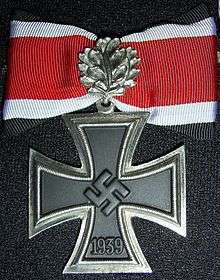Ludwig Becker (pilot)
| Ludwig Becker | |
|---|---|
 | |
| Born |
22 August 1911 Dortmund-Aplerbeck, Germany |
| Died |
26 February 1943 (aged 31) north of Schiermonnikoog in the North Sea |
| Allegiance |
|
| Service/branch |
|
| Years of service | 1939–43 |
| Rank | Hauptmann of the Reserves |
| Unit | NJG 1 |
| Commands held | 12./NJG 1 |
| Battles/wars |
World War II |
| Awards | Knight's Cross of the Iron Cross with Oak Leaves |
Ludwig Becker (22 August 1911 – 26 February 1943) was a Luftwaffe fighter ace and recipient of the Knight's Cross of the Iron Cross with Oak Leaves (German: Ritterkreuz des Eisernen Kreuzes mit Eichenlaub) during World War II. The Knight's Cross of the Iron Cross and its higher grade Oak Leaves was awarded to recognise extreme battlefield bravery or successful military leadership. Becker claimed 46 aerial victories.[Note 1]
Career
Ludwig Becker was born on 22 August 1911 in Dortmund-Aplerbeck in the Province of Westphalia, a province of the Kingdom of Prussia. Joining the Luftwaffe volunteers in 1934, by 1939 he was a test pilot and a Leutnant in the Luftwaffe reserve. Serving with Nachtjagdgeschwader 1 (NJG 1—1st Night Fighter Wing), he crashed a Messerschmitt Bf 110 near Winterswijk on 30 August 1940.[Note 2]
His first victory was a Vickers Wellington on the night of 16/17 October 1940. Becker was flying a Dornier Do 17Z-10 equipped with a gun-camera. The victory recorded the demise of the No. 311 Squadron RAF aircraft piloted by Pilot Officer Bohumil Landa and three of his Czech crew. It was also the first radar-controlled "Dunkle Nachtjagd" (DuNaJa—dark night fighting, without search lights) victory of the war. He was later equipped with the Dornier Do 215B night fighter (code G9+OM) equipped with Lichtenstein radar. He achieved six victories between 10 August and 30 September 1941 in this machine. Becker developed his own tactics for attacking a bomber. He would trail the aircraft from the stern, just below the height shown on the radar. After sighting the bomber, he dived and accelerated to avoid being spotted by the tail gunner. Once underneath the enemy, Becker reduced the throttle and matched the speed of the unsuspecting pilot. Becker then climbed steadily to 50 ft (164 m) from the target before he pulled up and opened fire. Because the Do 215 lost speed the bomber would fly ahead and the through the stream of shells. With this method, the gun sight was rarely needed.[1]
He was awarded the Knight's Cross of the Iron Cross in July 1942, he then served as a Staffelkapitän (squadron leader) in 12./NJG 1. By the end of the year, Becker had some 40 victories to his credit.
Becker and his Radar Operator Oberfeldwebel Josef Straub (who had taken part in 40 victories) were posted missing in action on 26 February 1943 in a Bf 110G-4 while on a daylight mission intercepting a Boeing B-17 formation over the North Sea, and crashing north of Schiermonnikoog in the Netherlands.
All his 46 victories were at night.
Awards
- Ehrenpokal der Luftwaffe (2 March 1942)[2]
- Iron Cross (1939)
- German Cross in Gold on 24 April 1942 as Oberleutnant in the 6./NJG 2[5][Note 3]
- Knight's Cross of the Iron Cross with Oak Leaves
- Mentioned in the Wehrmachtbericht on 21 January 1942, 26 March 1942, 7 June 1942 and on 26 June 1942
Notes
- ↑ For a list of Luftwaffe night fighter aces see List of German World War II night fighter aces.
- ↑ For an explanation of the meaning of Luftwaffe unit designation see Organization of the Luftwaffe during World War II.
- ↑ According to Obermaier on 4 May 1942.[2]
- 1 2 According to Scherzer as Oberleutnant of the Reserves and Staffelkapitän of the 6./NJG 1.[7]
References
Citations
Bibliography
- Fellgiebel, Walther-Peer (2000) [1986]. Die Träger des Ritterkreuzes des Eisernen Kreuzes 1939–1945 — Die Inhaber der höchsten Auszeichnung des Zweiten Weltkrieges aller Wehrmachtteile [The Bearers of the Knight's Cross of the Iron Cross 1939–1945 — The Owners of the Highest Award of the Second World War of all Wehrmacht Branches] (in German). Friedberg, Germany: Podzun-Pallas. ISBN 978-3-7909-0284-6.
- MacLean, French L. (2007). "Luftwaffe Efficiency & Promotion Reports — For the Knight's Cross Winners". Atglen, Pennsylvania: Schiffer Military History. ISBN 978-0-7643-2657-8.
- Obermaier, Ernst (1989). Die Ritterkreuzträger der Luftwaffe Jagdflieger 1939 – 1945 [The Knight's Cross Bearers of the Luftwaffe Fighter Force 1939 – 1945] (in German). Mainz, Germany: Verlag Dieter Hoffmann. ISBN 978-3-87341-065-7.
- Patzwall, Klaus D.; Scherzer, Veit (2001). Das Deutsche Kreuz 1941 – 1945 Geschichte und Inhaber Band II [The German Cross 1941 – 1945 History and Recipients Volume 2] (in German). Norderstedt, Germany: Verlag Klaus D. Patzwall. ISBN 978-3-931533-45-8.
- Scherzer, Veit (2007). Die Ritterkreuzträger 1939–1945 Die Inhaber des Ritterkreuzes des Eisernen Kreuzes 1939 von Heer, Luftwaffe, Kriegsmarine, Waffen-SS, Volkssturm sowie mit Deutschland verbündeter Streitkräfte nach den Unterlagen des Bundesarchives [The Knight's Cross Bearers 1939–1945 The Holders of the Knight's Cross of the Iron Cross 1939 by Army, Air Force, Navy, Waffen-SS, Volkssturm and Allied Forces with Germany According to the Documents of the Federal Archives] (in German). Jena, Germany: Scherzers Militaer-Verlag. ISBN 978-3-938845-17-2.
- Thomas, Franz (1997). Die Eichenlaubträger 1939–1945 Band 1: A–K [The Oak Leaves Bearers 1939–1945 Volume 1: A–K] (in German). Osnabrück, Germany: Biblio-Verlag. ISBN 978-3-7648-2299-6.
- Die Wehrmachtberichte 1939–1945 Band 2, 1. Januar 1942 bis 31. Dezember 1943 [The Wehrmacht Reports 1939–1945 Volume 2, 1 January 1942 to 31 December 1943] (in German). München, Germany: Deutscher Taschenbuch Verlag GmbH & Co. KG. 1985. ISBN 978-3-423-05944-2.
